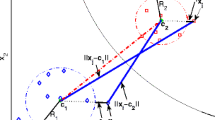Abstract
Margin setting algorithm (MSA) is a new sphere-based classification algorithm. It employs an artificial immune system approach to construct a number of hyperspheres that cover each class of a given set of data. To gain insights into the classification performance of MSA, it is the first work to analyze two important fundamental problems of MSA as a sphere-based classifier. First, single sphere or multiple spheres are needed to achieve good classification performance in MSA? This problem was presented as sphere analysis, which was experimentally carried out on simulation data sets using Monte Carlo method. The results demonstrated that MSA employs a multiple-sphere strategy instead of one-sphere strategy as its decision boundaries. This strategy allows MSA to achieve lower probabilities of classification error rate. Second, how to adapt the location and size of the hypersphere to achieve good classification performance? This problem was presented as adaption analysis, which was experimentally carried out on real-world data sets compared to the support vector machine and the artificial neural network. The results demonstrated that MSA employs an artificial immune system approach to optimize the locations of the hyperspheres and to shrink the radius of the hypersphere in a certain range using margin as an algorithm parameter. Overall, computational results indicate the advantages of MSA in classification performance.








Similar content being viewed by others
References
Takigawa I, Kudo M, Nakamura A (2009) Convex sets as prototypes for classifying patterns. Eng Appl Artif Intell 22(1):101–108
Takigawa I, Kudo M, Nakamura A (2005) The convex subclass method: combinatorial classifier based on a family of convex sets. In: International workshop on machine learning and data mining in pattern recognition. Springer, pp 90–99
Cooper PW (1962) The hypersphere in pattern recognition. Inf Control 5(4):324–346
Cooper PW (1966) A note on an adaptive hypersphere decision boundary. IEEE Trans Electron Comput 6:948–949
Batchelor BG (1978) Classification and data analysis in vector spaces. In: Batchelor BG (ed) Pattern recognition. Springer, Berlin, pp 65–116
Sui C, Kwok NM, Ren T (2011) A restricted coulomb energy (rce) neural network system for hand image segmentation. In: 2011 Canadian conference on computer and robot vision. IEEE, pp 270–277
Scofield CL, Reilly DL, Elbaum C, Cooper LN (1988) Pattern class degeneracy in an unrestricted storage density memory. In: Neural information processing systems, pp 674–682
Lee Y (1989) Classifiers: adaptive modules in pattern recognition systems. Massachusetts Institute of Technology
Marchand M, Shawe-Taylor J (2002) The set covering machine. J Mach Learn Res 3:723–746
Caulfield HJ, Karavolos A, Ludman JE (2004) Improving optical Fourier pattern recognition by accommodating the missing information. Inf Sci 162(1):35–52
Wang J, Neskovic P, Cooper LN (2005) Pattern classification via single spheres. In: International conference on discovery science. Springer, pp 241–252
Hao P-Y, Lin Y-H (2007) A new multi-class support vector machine with multi-sphere in the feature space. In: International conference on industrial, engineering and other applications of applied intelligent systems. Springer, pp 756–765
Wang J, Neskovic P, Cooper LN (2006) A minimum sphere covering approach to pattern classification. In: 18th international conference on pattern recognition (ICPR’06). IEEE, pp 433–436
Wang J, Neskovic P, Cooper LN (2006) Learning class regions by sphere covering. Brown University, Providence, RI, IBNS Technical Report 2:2006
Olmez T (1997) Classification of ECG waveforms by using RCE neural network and genetic algorithms. Electron Lett 33(18):1561–1562
Younsi R, Bagnall A (2012) An efficient randomised sphere cover classifier. Int J Data Min Model Manag 4(2):156
Younsi R, Bagnall A (2016) Ensembles of random sphere cover classifiers. Pattern Recognit 49:213–225
Fu J, Caulfield HJ, Wu D, Tadesse W (2010) Hyperspectral image analysis using artificial color. J Appl Remote Sens 4(1):043514
Wang Y, Adhami R, Fu J (2015) A new machine learning algorithm for removal of salt and pepper noise. In: Seventh international conference on digital image processing (ICDIP 2015). International Society for Optics and Photonics, p 96311R
Wang Y, Adhmai R, Fu J, Al-Ghaib H (2015) A novel supervised learning algorithm for salt-and-pepper noise detection. Int J Mach Learn Cybern 6(4):687–697
Wang Y, Fu J, Adhami R, Dihn H (2016) A novel learning-based switching median filter for suppression of impulse noise in highly corrupted colour images. Imaging Sci J 64(1):15–25
Wang Y, Amin MM, Fu J, Moussa HB (2017) A novel data analytical approach for false data injection cyber-physical attack mitigation in smart grids. IEEE Access 5:26022–26033
Wang Y, Pan WD, Fu J (2015) Analysis of the margin setting algorithm as a margin-based spherical classification method. In: SoutheastCon 2015. IEEE, pp 1–7
Wang Y, Fu J, David Pan W (2018) Impact of setting margin on margin setting algorithm and support vector machine. J Imaging Sci Technol 62(3):30501–30511
Schapire RE, Freund Y (2013) Boosting: foundations and algorithms. Kybernetes
Qi Z, Meng F, Tian Y, Niu L, Shi Y, Zhang P (2017) Adaboost-llp: a boosting method for learning with label proportions. IEEE Trans Neural Netw Learn Syst 29(8):3548–3559
Hofmeyr SA, Forrest S (2000) Architecture for an artificial immune system. Evolut Comput 8(4):443–473
Hammersley J (2013) Monte carlo methods. Springer, Berlin
Rubinstein RY, Kroese DP (2016) Simulation and the Monte Carlo method, vol 10. Wiley, Hoboken
Asuncion A, Newman D (2007) UCI machine learning repository
Cortes C, Vapnik V (1995) Support-vector networks. Mach Learn 20(3):273–297
Kubat M (2015) Artificial neural networks. In: An introduction to machine learning. Springer, Cham, pp 91–111
Author information
Authors and Affiliations
Corresponding author
Ethics declarations
Conflict of interest
All authors declare that they have no conflict of interest.
Ethical approval
This article does not contain any studies with human participants or animals performed by any of the authors.
Additional information
Publisher's Note
Springer Nature remains neutral with regard to jurisdictional claims in published maps and institutional affiliations.
Rights and permissions
About this article
Cite this article
Wang, Y., Pan, W.D., Fu, J. et al. Margin setting algorithm for pattern classification via spheres. Pattern Anal Applic 23, 1677–1688 (2020). https://doi.org/10.1007/s10044-020-00888-3
Received:
Accepted:
Published:
Issue Date:
DOI: https://doi.org/10.1007/s10044-020-00888-3




